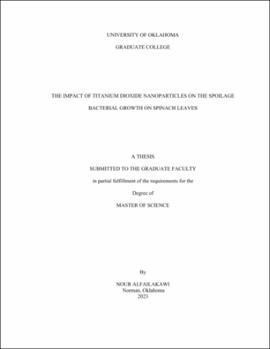| dc.contributor.advisor | Strevett, Keith | |
| dc.contributor.author | Alfailakawi, Nour | |
| dc.date.accessioned | 2023-05-03T19:51:36Z | |
| dc.date.available | 2023-05-03T19:51:36Z | |
| dc.date.issued | 2023-05 | |
| dc.identifier.uri | https://hdl.handle.net/11244/337526 | |
| dc.description.abstract | Nanoparticles are increasingly being considered for various agricultural applications, ranging from nano-based fertilizers to nano-pesticides that can easily attach to the produce. This work aspires to isolate spoilage bacteria from spinach leaves, determine the surface electrodynamic energies of bacteria isolates, evaluate the impact of nanoparticles on bacterial attachment from leafy vegetables, and determine the changes in Lifshitz-van der Waals and Lewis Acid/Base interfacial forces of bacteria in the surface with and without the presence of nanoparticles. It was hypothesized that titanium dioxide reduces the growth of spoilage bacteria on spinach leaves. The methods were divided into six sections: bacterial growth, isolating bacterial consortiums, contact angle measurements, xDLVO model, bacterial growth with the presence of titanium dioxide, and statistical analysis. Spinach spoilage took 35 days to form; LB media (Lysogeny broth) was used then for bacterial growth as the most recognized bacteria found was likely to be Erwinia species.
It was found that the addition of high titanium dioxide concentrations resulted in a decreased number of colony-forming units. Still, low titanium dioxide concentrations showed no statistical difference from bare spinach leaves. The Gibbs free energies of attachment for both Lifshitz-van der Waals and Lewis acid-base interactions were calculated to be negative for Erwinia with spinach leaves but positive for Erwinia with titanium dioxide. Because negative free energies correspond to a favorable interfacial thermodynamic interaction, and positive free energies correspond to an unfavorable interaction, this difference may partially explain the different observed spoilage behaviors in the absence and presence of titanium dioxide. | en_US |
| dc.language | en_US | en_US |
| dc.rights | Attribution-NonCommercial-NoDerivatives 4.0 International | * |
| dc.rights.uri | https://creativecommons.org/licenses/by-nc-nd/4.0/ | * |
| dc.subject | Agriculture, General. | en_US |
| dc.subject | xDLVO theory | en_US |
| dc.subject | Bacterial Growth | en_US |
| dc.subject | Nanoparticles | en_US |
| dc.title | The Impact of Titanium Dioxide Nanoparticles on the Spoilage Bacterial Growth on Spinach Leaves | en_US |
| dc.contributor.committeeMember | Kibbey, Tohren | |
| dc.contributor.committeeMember | Vogel, Jason | |
| dc.date.manuscript | 2023-05 | |
| dc.thesis.degree | Master of Science in Environmental Engineering | en_US |
| ou.group | Gallogly College of Engineering::School of Civil Engineering and Environmental Science | en_US |
| shareok.nativefileaccess | restricted | en_US |

